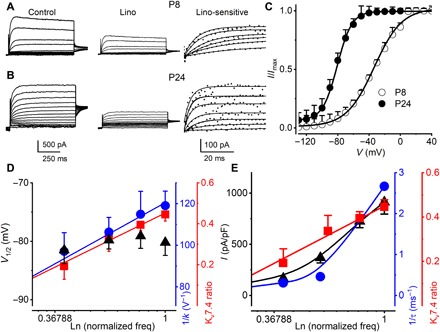Fig. 2. Outward K+ currents in mouse OHCs show sensitivity toward lino and a profound negative shift in the steady-state voltage-dependent activation and fast onset of activation time constant (τact) during development.

The linopirdine (lino)–sensitive current (IKn) in OHCs increases in density and shows a smaller τact as Kv7.4 cluster density increases. (A and B) Currents elicited in response to voltage steps in P8 to P24 OHCs from mice were recorded from the cochlear location at CF of 3 to 4 kHz. Currents were elicited by applying voltage steps from −130 mV with increasing voltage steps in 10-mV increments. Deactivation voltage steps were at −30 mV. The sensitivity of the current was tested with 200 μM lino, and the difference current (in dotted plots) was fitted with one exponential function shown in solid lines to obtain time constants of activation (τact). (C) Current density (I)–voltage (V) relations fitted with a single Boltzmann function of the form I(V) = Imax/[1 + exp.(−(V − V1/2))/k], where Imax is the maximum current density, V is the membrane voltage, V1/2 is the half-activation voltage, and 1/k is the voltage sensitivity at half-activation. The V1/2 (in mV) and 1/k (in V−1) for the currents at P8 and P24 were −33.6 ± 1.0 and 56.5 ± 5.1 (n = 15) and −81.1 ± 1.7 and 97.1 ± 6.0 (n = 17), respectively. Comparing V1/2 and 1/k at P8 and P24 currents (V1/2, P < 0.0001 and 1/k, P < 0.0001). (D) Relations between V1/2 of IKn in P24 OHCs at different cochlear locations, showing no visible changes (▲). The voltage sensitivity at half-activation of IKn increased relative to frequency by 18 V−1 kHz−1 (●) and Kv7.4 fractional area ratio (■) as a function of CFs of OHCs. (E) IKn voltage dependence in P24 mouse OHCs from different frequency-place maps of the cochlea, representing CFs (in kHz) 2, 4, 6, and 10. Relations between the maximum current density (▲) measured in pA/pF, τact of currents at 0 mV (●), and fractional area ratio (●) as a function of CFs are shown for comparison.
